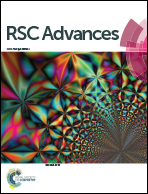A self-matting waterborne polyurethane coating with admirable abrasion-resistance
Abstract
Due to the paradox between abrasion-resistance and extinction, the development of a self-matting waterborne polyurethane (SMWPU) coating accompanied by excellent abrasion-resistance is still a challenge. Herein, a kind of hydroxyalkyl-terminated polysiloxane modified SMWPU was prepared and employed for matting leather/synthetic leather finishing. Simultaneously, the influences of hydrophilic chain extender and polysiloxane loadings on the matting effect and abrasion resistance of the coating were investigated in detail. The results indicated that the gloss of the coating was closely related to the hydrophilic chain extender content, and a stable emulsion and optimal matting effect could be achieved when a 1.6 wt% (based on solid content) hydrophilic chain extender was employed. With the introduction of polysiloxane, the silicon element content on the coating surface increased from 0% to 9.26%, just as expected, and an enhanced abrasion resistance of the coating was obtained. Specifically, the coating weight loss ratio was reduced from 2.36 wt% to 0.41 wt%, and obvious surface damage did not occur after 500 abrasions. Although the surface roughness and matting effect of the coating decreased slightly due to the introduction of silicone, the gloss of the modified coating was less than 1.5° (60° incidence angle), still exhibiting an excellent matting effect. Another interesting result was the elevation of anti-hot-pressing, compared with that of the unmodified one, and the gloss of the modified coating showed no changes under a 10 MPa, 150 °C hot-pressing condition.



 Please wait while we load your content...
Please wait while we load your content...